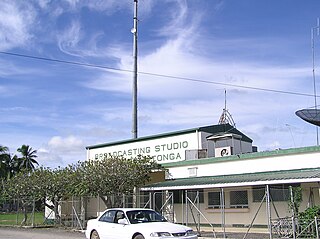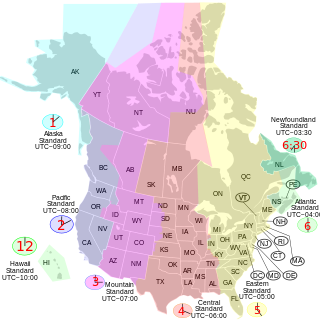Related Research Articles

Music of Tonga refers to music derived from the island Tonga in the islands of Polynesia. Music of Tonga today generally falls under the category of traditional music that has withstood the test of time, or into one of the two opposing genres of religious and secular music. Tongan music can be either very emotional and somewhat modern with instrumental makeup including modern brass instruments, or conversely can be more traditional and consist of only drums and voices. In this way, Tongan music is very diverse despite the fact that it is contained to a fairly small island, which means that the different cultures and styles co-exist on the small land mass together without blending.
Three, stylised as +HR=E, is a New Zealand nationwide television channel. Launched on 26 November 1989 as TV3, it was New Zealand's first privately owned television channel. The channel currently broadcasts nationally in digital free-to-air form via the state-owned Kordia on terrestrial and satellite. Vodafone also carries the channel for their cable subscribers in Wellington and Christchurch. It previously broadcast nationally on analogue television until that was switched off on 1 December 2013.

Malaysian television broadcasting was introduced on 28 December 1963. Colour television was introduced on 28 December 1978. Full-time colour transmissions were officially inaugurated on New Year's Day 1982. There are currently 16 national free-to-air terrestrial television channels in Malaysia and 3 national pay subscription television operators in Malaysia.
WFTY-DT is a television station licensed to Smithtown, New York, United States, serving Long Island and owned by TelevisaUnivision. Its main channel broadcasts the True Crime Network; it also rebroadcasts the main channels of its New York City–area Univision and UniMás stations, WXTV-DT and WFUT-DT, from its transmitter in Middle Island, New York.
CableView Services Sdn. Bhd., operating as Mega TV was Malaysia's first ever subscription-based pay television service. It was incorporated on 18 October 1994 and began transmissions on 1 November 1995 and was operated by Sistem Televisyen Malaysia Berhad (TV3), is a Malaysian free-to-air television network owned and operated by Malaysian Resources Corporation Berhad (MRCB).

WFUT-DT is a television station licensed to Newark, New Jersey, United States, serving as the UniMás outlet for the New York City area. WFUT-DT is owned and operated by TelevisaUnivision alongside Paterson, New Jersey–licensed Univision station WXTV-DT. The stations share studios on Frank W. Burr Boulevard in Teaneck, New Jersey, and transmitter facilities at the Empire State Building in Midtown Manhattan. The programming of both stations and True Crime Network is simulcast to Long Island and southern Connecticut from WFTY-DT, broadcasting from Middle Island, New York.

KTGM is a television station in Tamuning, Guam, serving the U.S. territory as an affiliate of ABC. It is owned by Sorensen Media Group and operated by Lilly Broadcasting alongside low-power Fox affiliate KEQI-LD. The two stations share studios on 111 Chalan Santo Papa in Hagåtña (Agana); KTGM's transmitter is located in the heights of Barigåda (Barrigada).
Super TV was an American subscription television service operating in the Washington, D.C., and Baltimore metropolitan areas. that was owned by Subscription Television of Greater Washington, Inc. It was an early form of subscription television that was offered to prospective subscribers as either a standalone service to those that did not have access to cable television-originated premium services, or as an additional viewing alternative thereto.
A timeshift channel is a television channel carrying time-delayed reruns of its "parent" channel's programming. This channel runs alongside their parent: the term timeshift does not refer to a network broadcasting at a later time to reflect a local time zone, unless the parent is also available. Often the timeshift channel's branding and advertising will be the same as that of the parent, with the channel number and respective timing being the only distinction between the two, but some, such as Channel 4 +1 in the United Kingdom and TVNZ 1+1 in New Zealand, will overlay a different digital on-screen graphic to distinguish the two channels. A few channels, like Film4 +1 in the United Kingdom, do not carry a digital on-screen graphic on its regular channel or its timeshift channel.

This is a list of when the first publicly announced television broadcasts occurred in the mentioned countries. Non-public field tests and closed circuit demonstrations are not included.

Television Tonga is a Tongan television channel operated by the Tonga Broadcasting Commission. It was founded on July 4, 2000 by King Taufa'ahau Tupou IV.
Oceania Broadcasting Network Began operating in 1991.

Pacific Broadcasting Services is a company jointly owned by City West Centre Broadcasting Services and BPHCL. Its core business is to deliver satellite subscription television and radio broadcasting services to the Fiji Islands and surrounding markets, focussing on both Hindi and English speaking households and commercial outlets.

The following outline is provided as an overview of and topical guide to Tonga:
The Baháʼí Faith in Tonga started after being set as a goal to introduce the religion in 1953, and Baháʼís arrived in 1954. With conversions and pioneers the first Baháʼí Local Spiritual Assembly was elected in 1958. From 1959 the Baháʼís of Tonga and their local institutions were members of a Regional Spiritual Assembly of the South Pacific. By 1963 there were five local assemblies. Less than forty years later, in 1996, the Baháʼís of Tonga established their paramount Baháʼí school in the form of the Ocean of Light International School. Around 2004 there were 29 local spiritual assemblies. The 2015 estimate of the World Religion Database ranked the Baháʼís at 3.5% of the national population, though as recently as 2006 the Tonga Broadcasting Commission maintained a policy that does not allow discussions by members of the Baháʼí Faith of its founder, Baháʼu'lláh on its radio broadcasts.
Sione Teisina Fuko is a Tongan politician and former Member of the Tongan Parliament for the island of Ha'apai. He is a member of the People's Democratic Party.

The scheduling of television programming in North America must cope with different time zones. The United States has six time zones, with further variation in the observance of daylight saving time. Canada also has six time zones. Mexico has four time zones. This requires broadcast and pay television networks in each country to shift programs in time to show them in different regions.
Home Video Channel (HVC) was a British cable television channel that began operating in 1985, broadcasting low-budget films between 8:00 p.m. and midnight. Film genres included horror, action, adventure, science fiction, and erotica. In 1992, a second channel, The Adult Channel, was launched by HVC's owner, Home Video Channel Limited (HVCL). It broadcast erotic films and softcore pornography.
VAP-TV18, also known as Vision of Pilolevu was a Tongan television channel owned by Siaosi Polutele Guttenbeil. The channel started terrestrial broadcasts in August 1983 in Nukuʻalofa being the first such television station in the country. Polutele had a three-hour-a-day - but not daily - schedule in what was considered to be a "do-it-yourself" format. Polutele had 20 years of experience in the field of television, working at television stations in New Zealand and as a TV repairman in the United States. The programming was entirely local: sports, news and current affairs. The television signal used by VAP-TV18 would reach a maximum of 100 television sets, aiming to cover the entirety of the island of Tongatapu. Startup costs for operation were estimated to be worth $10,000, with no charge to viewers, with the signal being entirely free-to-air. The station was supported by advertising, something a future competitor, ASTL-TV3, refused to carry until 1991.
The Marshalls Broadcasting Company (MBC) is the national broadcaster of the Marshall Islands. It operates one radio station, V7AB and one television channel.
References
- ↑ Do-it-yourself and Pay TV in Tonga, Pacific Islands Communication Journal, January/February 1987
- ↑ New vision for Tonga, Islands Business, October 1983
- ↑ Do-it-yourself and Pay TV in Tonga, Pacific Islands Communication Journal, January/February 1987
- ↑ "Cable TV plans for Asia and the Pacific". The Straits Times. 28 October 1983. Retrieved 12 February 2024.
- 1 2 3 The Tongan media and press freedom: The crucial role of independent media in the fight for press freedom in Tonga, Kitekei'aho Tu'akalau, 2005
- 1 2 3 4 Bentley, J.E.; Hermanson, D.; Rao, V.V. (September 1993). "PACIFIC REGIONAL TELEVISION SURVEY PROJECT – 352lRASl21 (PAC TEL)". UNESCO. Retrieved February 13, 2024.
- ↑ "Tonga - A Country Profile" (PDF). USAid. October 1986. Archived from the original (PDF) on 21 February 2017. Retrieved 12 February 2024.
- ↑ "Selected Issues in Pacific Island Development" (PDF). Australian National University. 1986. Archived from the original (PDF) on 18 March 2020. Retrieved 12 February 2024.
- ↑ Tonga private TV needs 200 subscribers, Pacific Magazine, January/February 1987
- ↑ Tonga TV scramble, Pacific Islands Monthly, January 1989